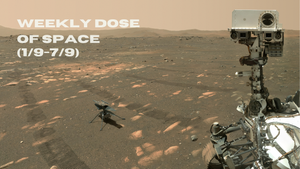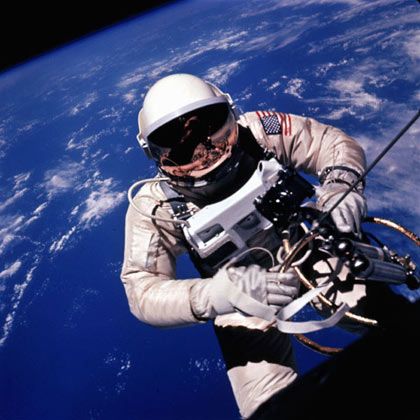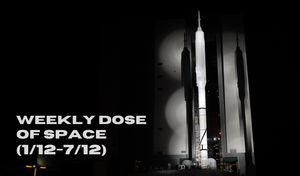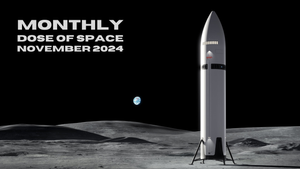
Weekly Dose of Space (1/9-7/9)
Welcome back to Weekly Dose of Space! This week had five orbital launches occur, with one being the final flight of a European launch vehicle. News this week had Tianwen-3's launch moving two years closer, another nation joining the International Lunar Research Station, and Starliner returning to Earth. As always, we'll also look ahead to what the worldwide launch schedule might look like next week.
SpaceX
This week at Starbase began on September 2nd when workers were seen underneath Starhopper preparing to move it. On September 3rd, one of the self-propelled modular transporters rolled under Starhopper, and workers installed stands to enable Starhopper's move. Starhopper was also chained to the transporter.
Late on the 3rd, Starhopper was moved out of the launch site and into one of SpaceX's spare lots neighboring the launch site.
A few days later on the 5th of September, the 'chopsticks' of Orbital Launch Tower 1 were raised for testing. These tests are believed to have been simulating part of a booster catch, which is expected to occur on the next flight test of Starship-Super Heavy.
September 6th had Ship 31 roll out from the production site to the Massey's test site, possibly ahead of a static fire. Ship 31 is currently expected to fly on the sixth flight test.
Launches This Week
September 3rd - Long March 4B with Yaogan-43 Group-02
A Long March 4B lifted off from the Xichang Satellite Launch Center carrying a believed six satellites into low Earth orbit. These satellites were the second group of spacecraft launched for Yaogan-43, which is stated as being for testing low Earth orbit constellation technologies.

September 5th - Vega with Sentinel-2C
Arianespace launched its final Vega rocket from Ensemble de Lancement Vega at the Guiana Space Center, in French Guiana. Sentinel-2C was successfully delivered to sun-synchronous orbit, where it will begin providing high-resolution imagery for land surveying.

September 5th - Falcon 9 with Starlink Group 8-11
SpaceX launched another twenty-one Starlink satellites to low Earth orbit atop of a Falcon 9 from Space Launch Complex 40, in Florida. The booster for this mission was B1o77 flying for the fifteenth time, and landing downrange on the drone ship 'Just Read the Instructions'.

September 5th - Long March 6 with Group-03 of Geespace's constellation
A Long March 6 launched from the Taiyuan Satellite Launch Center carrying ten satellites into low Earth orbit. The ten satellites were for Geespace’s Geely Future Mobility Constellation.

September 6th - Falcon 9 with NROL-113
Another Falcon 9 launched from Space Launch Complex 4E, in California, for the NROL-113 mission for the U.S. National Reconnaissance Office, believed to be carrying a batch of Starshield satellites for military use. The booster for this mission was B1063, flying for the twentieth time and landing on the drone ship 'Of Course I Still Love You' downrange.

In Other Space News
Senegal joins the ILRS project

Senegal became the thirteenth country to sign onto the China-led International Lunar Research Station on September 5th, announced by China's Deep Space Exploration Laboratory. The Memorandum of Understanding on the International Lunar Research Station was signed by Maram Kairé, Director of the Senegalese Space Agency, on behalf of the Republic of Senegal and Li Guoping (李国平), Chief Engineer of the China National Space Administration, on behalf of the People's Republic of China.
Senegal now joins Kazakhstan, Serbia, Nicaragua, Thailand, Egypt, Belarus, Russia, Pakistan, Azerbaijan, South Africa, Venezuela, and China as a member nation on the project, which hopes to have an operational lunar research base by the end of 2035.
Alongside this signing, the Belgrade Observatory in Serbia, Spacetalk in Switzerland, the Emirates Orbital Space Company, the Panama Space Science Innovation Center, Banda Lampung University in Indonesia, the National University of Science and Technology in Pakistan, the Belt and Road Science and Technology Association, the South African Radio Astronomy Observatory, the Africa Ten international organizations including the Space Development Foundation and the African Business Alliance also signed Memorandums of Understanding for the lunar station as subnational partners, which was also announced by the Deep Space Exploration Laboratory.
Starliner returns uncrewed

Starliner's Crew Flight Test mission finally came to a close on September 7th when it touched down at the White Sands Space Harbor, in New Mexico. Boeing and NASA had originally intended for Starliner to spend a little over eight days at the International Space Station, it instead spent almost three months docked.
Starliner returned from the space station uncrewed due to NASA's lack of confidence in the vehicle. Sunita Williams and Butch Wilmore, who launched onboard Starliner, remain aboard the International Space Station and are set to return in February 2025, on a Crew Dragon for the Crew-9 mission.
During its return to Earth, Starliner is not believed to have run into any major issues. Further details about the mission, crew decision, and the future are available here.
Tianwen-3 expected to launch NET 2028

Xinhua reported on September 5th that the Tianwen-3 Mars sample return mission is slated to launch no earlier than 2028. The mission was originally believed to be targeting 2030.
Liu Jizhong, Chief Designer of the Tianwen-3 mission, spoke to Xinhua and said the following about the mission:
"China has retrieved the first ever samples from the far side of the moon with the Chang'e-6 mission this year. Since Mars is much farther away than the moon, it will take two launches to carry out the Mars sample-return mission due to the limited carrying capacities of our current rockets. Two Long March-5 carrier rockets will be used for the mission"
The Tianwen-3 mission will utilize two launches to send the major mission elements to Mars. These major elements are an Orbiter-Return module and a Lander-Ascent module.
The Orbtier-Return module will enter orbit of Mars and perform various scientific experiments while awaiting the samples. The Lander-Ascent module will land on Mars, gather samples, and deliver those samples to the Returner. Once the samples are onboard, the Orbiter-Return will begin the journey back to Earth, the Return capsule will separate from the module in the days before reentry.
If successful, the samples will arrive back on Earth around 2031.
What to Expect Next Week
Starbase
As we have been reporting for the last few weeks, the fifth test flight of SpaceX's Starship-Super Heavy vehicle is still awaiting regulatory approval from the U.S. Federal Aviation Administration. This latest flight test requires a change in the flight plan, notably a potential landing of Booster 12 back at the launch site on the launch towers 'chopsticks'.
Both vehicles for flight five, Booster 12 and Ship 30, are ready for flight pending a possible wet dress rehearsal.
September 9th - Falcon 9 with Polaris Dawn
The Polaris Dawn mission is expected to launch from Launch Complex 39A, in Florida, on a Falcon 9 carrying it to low Earth orbit with four crew onboard. In addition to conducting medical research, the mission would test extravehicular spacesuits made by SpaceX and laser-based Starlink communications on Crew Dragon.
The crew for Polaris Dawn is Commander Jared Isaacman, Pilot Scott Poteet, Mission Specialist Anna Menon, and Mission Specialist Sarah Gillis.
September 11th - H2A with IGS-Radar 8
A H2A rocket is expected to launch from the Tanegashima Space Center carrying the IGS-Radar 8 reconnaissance satellite to a sun-synchronus orbit.
September 11th - Soyuz 2.1a with MS-26
A Soyuz rocket is expected to launch from the Baikonur Cosmodrome carrying three astronauts aboard the Soyuz MS-26 spacecraft. The three astronauts are Roscosmos' Alexey Ovchinin and Ivan Vagner as well as NASA's Donald Pettit.
September 12th - Falcon 9 with BlueBird Block 1
SpaceX is expecting to launch five commercial cellphone-compatible broadband satellites into low Earth orbit from Space Launch Complex 40 for AST SpaceMobile’s broadband constellation. The booster for this mission is unknown, but it is expected to land back at Landing Zone 1.




